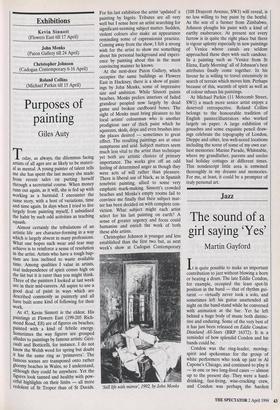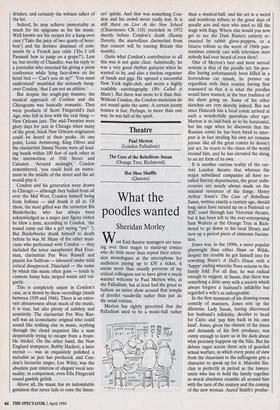Jazz
The sound of a girl saying 'Yes'
Martin Gayford
It is quite possible to make an important contribution to jazz without blowing a horn or beating a drum. The late Eddie Condon, for example, occupied the least spot-lit position in the band — that of rhythm gui- tarist — virtually never took a solo, and sometimes left his guitar unattended all night on the band-stand while he conversed with animation at the bar. Yet he left behind a huge body of music both distinc- tive and enduring. Some of the very best of it has just been released on Eddie Condon: Dixieland All-Stars (BRP 16372). It is a reminder of how splendid Condon and his bands could be.
Condon was the ring-leader, moving- spirit and spokesman for the group of white performers who took up jazz in Al Capone's Chicago, and continued to play it — in one or two long-lived cases — almost up to the present day. They were a hard- drinking, fast-living, wise-cracking crew, and Condon was perhapi, the hardest drinker, and certainly the wittiest talker of the lot.
Indeed, he may achieve immortality as much for his epigrams as for his music. Well known are his recipes for a hang-over cure (`Take the juice of two quarts of bour- bon') and his derisive dismissal of com- ments by a French jazz critic (Do I tell Panassie how to jump on a grape?'). Less so, but worthy of Chandler, was his reply to a journalist who resented his giving a press conference while lying face-down on his hotel bed — 'Can't you sit up?' You must understand' mumbled the seriously hung- over Condon, 'that I am not an athlete.'
But despite the tough-guy manner, the musical approach of Condon and the Chicagoans was basically romantic. They were products of Scott Fitzgerald's Jazz Age, who fell in love with the real thing — New Orleans jazz. The mid-Twenties were glory days for jazz in Chicago when many of the great, black New Orleans originators could be heard at their peaks. At one point, Louis Armstrong, King Oliver and the clarinettist Jimmy Noone were all lead- ing bands within 100 feet of each other at the intersection of 35th Street and Calumet. 'Around midnight,' Condon remembered, 'you could hold an instru- ment in the middle of the street and the air would play it.'
Condon and his generation were drawn to Chicago — although they hailed from all over the Mid West, Condon himself being from Indiana — and drank it all in. Of these, the most gifted was the cornettist Bix Beiderbecke, who has always been acknowledged as a major jazz figure (when he blew a note, according to Condon, 'the sound came out like a girl saying "yes" '). But Beiderbecke drank himself to death before he was 30. Many of the other musi- cians who performed with Condon — they included the tenor saxophonist Bud Free- man, clarinettist Pee Wee Russell and pianist Joe Sullivan — laboured under mild critical disapproval. Dixieland — the name by which this music often goes — tends to connote funny hats, striped waists and vul- garity.
This is completely unjust in Condon's case, as is shown by these recordings (made between 1939 and 1946). There is an extro- vert abrasiveness about much of the music, it is true, but also plenty of subtlety and sensitivity. The clarinettist Pee Wee Rus- sell was an iconoclastic original who could sound like nothing else in music, scything through the chord sequence like a man desperately trying to escape from a bram- ble thicket. On the other hand, the New England trumpeter, Bobby Hackett, a later recruit — was as exquisitely polished a melodist as jazz has produced, and Con- don's favourite singer, Lee Wiley, was the absolute past mistress of elegant vocal sen- suality; in comparison, even Ella Fitzgerald sound gawkily girlish.
Above all, the music has an indomitable gutsiness that never fails to raise the listen- ers' spirits. And that was something Con- don and his crowd never really lost. It is still there on Live At the New School (Chiaroscuro CR 110) recorded in 1972 shortly before Condon's death (Kenny Davern, the marvellous clarinettist from that concert will be touring Britain this month).
Quite what Condon's contribution to all this was is not quite clear. Admittedly, he was a very good rhythm guitarist when he wanted to be, and also a tireless organiser of bands and gigs. He opened a successful New York night-club, and wrote a highly readable autobiography (We Called it Music). But there was more to it than that. Without Condon, the Condon musicians do not sound quite the same. A certain jaunty bounce is lost. Perhaps, in more than one way, he was full of the spirit.



























































 Previous page
Previous page